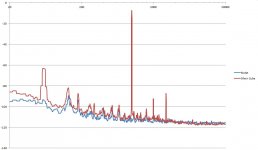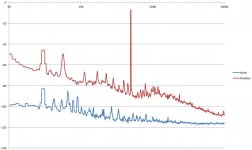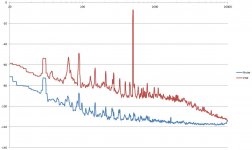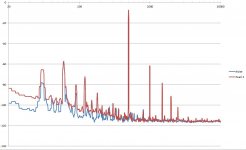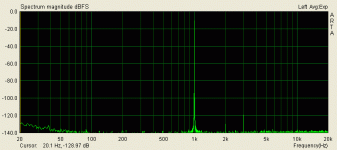I built a shielded 100:10 attenuator as you instructed and Wow 😀 the noise floor just drop drastically. I still have the supply 60/120 Hz spurious though even with the battery powered preamp.
 Before and after charts pics are appropriate now like they do on hair implant commercials.😀
Before and after charts pics are appropriate now like they do on hair implant commercials.😀P.S. Try ground lifting or loop breaking with resistor too.
Ok. My setup seems to be not to bad now. I close every load, soldering iron, fluo lamp, etc. I use a 100:1 attenuator at the input (1K input, shunt to 10R at the output) going through an insulation transformer (1:1 Edcor Audio coupling transformer) to cut any ground loop. When measuring noise I plug a short at the input. I tried with or without a ground lift (two diodes back to back) with no change.
First this is the baseline I guest, one of my best preamp, noise wise with the JLTi, the Lehmann Silver Cube. I prove my setup is correct, noise floor is mostly lower than -100dBV. Preamp noise floor is in Blue, 0dBV-1Khz in red. THD measured at 1Khz is a very low 0.016%
First this is the baseline I guest, one of my best preamp, noise wise with the JLTi, the Lehmann Silver Cube. I prove my setup is correct, noise floor is mostly lower than -100dBV. Preamp noise floor is in Blue, 0dBV-1Khz in red. THD measured at 1Khz is a very low 0.016%
Attachments
Last edited:
This is my Paradise. Noise floor is as good as the Silver Cube. Noise increase with the actual signal. Starnge the Paradise and the Sutherland don't seem to like my test setup. THD is very low at 0.013%
Attachments
Last edited:
Here the Vacuum State JLTi. That one is the low noise champion! Still low THD at 0.014%
Attachments
Last edited:
The Sutherland PHd, battery powered, strangely there is still line spurious present...Looking kind like the Paradise. THD at 0.013%
Attachments
Last edited:
And my own version of the PassLabs Pearl 2. This one has the highest THD at 0.2%. The Pearl 2 may be more comfortable with a MM cartridge, hence the 10R at the input may be too low for its taste.. We can see it in the harmonics. In a few days I'll add some more preamp, the Vacuum State SVP2 (Tube), the K&K Maxeed Out (Tube and Step-up transformer), the PassLabs Xono & Pearl and the Graham Slee (MM only). Will see...
Attachments
Last edited:
Its not from the devices under test PSU or ground loops it seems. Maybe its the computer. If its the newer USB Clio and not the older tower card one try it on a battery run laptop.
It is the Clio version running with an ISA card inside the computer and a small interface box outside, sorry no laptop running on battery. This is what I think, it may well be from the Clio generator inside the computer. All my other generators are more noisy and with more distortion than the Clio. Some preamps have very low noise floor though like the Silver Cube and the JTLi.
Last edited:
And my own version of the PassLabs Pearl 2. This one has the highest THD at 0.2%. The Pearl 2 may be more comfortable with a MM cartridge, hence the 10R at the input may be too low for its taste.. We can see it in the harmonics. In a few days I'll add some more preamp, the Vacuum State SVP2 (Tube), the K&K Maxeed Out (Tube and Step-up transformer), the PassLabs Xono & Pearl and the Graham Slee (MM only). Will see...
Its not the 10R , that is better as a noise source Johnson in any case, its the level. Run it at 0.5mV bcs it has a non NFB head amp.
...still the Pearl did better 20Hz noise figure when running with signal (no hum there so we can see better).
It is the Clio version running with an ISA card inside the computer and a small interface box outside, sorry no laptop running on battery. This is what I think, it may well be from the Clio generator inside the computer. All my other generators are more noisy and with more distortion than the Clio. Some preamps have very low noise floor though like the Silver Cube and the JTLi.
Try without the Edcor 1:1 coupling too. Maybe attracts fields. Just a shielded coax loop and the shielded attenuator.
With USB external card like EMU, M-Audio etc. plus Arta software or alike and a cheap second hand notebook on battery its not unusual to get reliable enough results. Takes a little caution only. Here is a baseline with my old EMU tracker that sadly has good drivers only on Windows XP.
Attachments
Sure you do good work. That does not make me unhappy. With Opamps it seems to be more easy then doing it discrete. Also your design is MM and not MC.
I haven't saved my Paradise charts but I remember they were flirting -100dB ref 0dbV at 20Hz and 62dB gain. PMA's chart is +6dbV ref and 40dB gain. Normalized they should compare.
Algar, great work.
shoom, the 2mV offset you get now is more or less the offset of the Opamp used as servo.
When you want even better you need to use something like an OPA627 that is specced down to 0.1mV.
Hi Joachim
after looking through my parts box I found that I had AD827 which the data sheet States are good for 16V max so I avoided them.(not the same beast or just conservatively rated?)
After reading Agar’s comments I became curious and ordered OPA627 from Farnell which arrived this morning.
Ouch pretty expensive but not really costly in the context of the overall build.😎
So plugged them in and wow 😀
DC offset is now mostly in the +/- 0.5mv range wandering up to 1.1mv Max very occasionally.
Great results and much more stable than the 134 IMHO.
Well worth the expense for peace of mind and maybe a part to include in the Build guide as a low DC offset alternative for the DC couplers.
BTW I needed 1600 transistors to get two full sets (I matched for an Atlas less friend and we shared the cost)🙄
Our front ends are a dead match hfe431 and all others matched to 0.5% ish.
So now really happy with the low DC offset. Thanks for suggesting the 627 they helped quite a lot.
Now the listening.🙂
- Home
- Source & Line
- Analogue Source
- Paradise Builders
